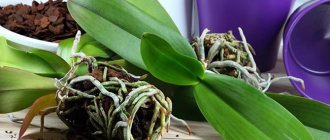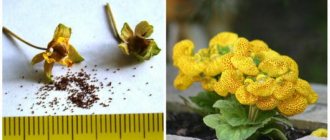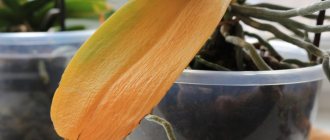An interesting fact is that women are increasingly given not cut flowers in a bouquet, but indoor plants in pots. The snow-white spathiphyllum is in the lead; caring for it at home is simple; many women and girls dream of receiving such a gift. Why is that?
The flower is called lady's happiness; spathiphyllum brings coziness, comfort and female happiness to the house. The plant looks great in the home interior, but sometimes it starts to hurt. Today on the agenda are the features of caring for spathiphyllum.
Period for active growth
Does this flower grow quickly? Like any living creature, this plant has a period of more active growth and times when its development slows down.
The winter months are a time when all processes in a flower freeze, so you should not expect active growth during this period.
Another thing is the onset of the warm season, when spathiphyllum begins its active growth and flowering. Although it is possible that your flower may release an arrow with a flower in the month of December. On average, spathiphyllum should produce 2-3 leaves per month.
Spathiphyllum does not grow
If you are new to indoor floriculture, and you were given a spathiphyllum, home care for you will be to ensure that the plant does not stop growing and new leaves appear. At first, this is what happens - there will be vigorous growth and you will have a desire to plant the plant, but then the flower will no longer want to grow.
Spathiphyllum does not grow among amateur gardeners for only two reasons:
- Large pot - its diameter is much larger than the plant needs.
- Transplanted plants are exposed to too bright sunlight or, conversely, removed into deep shade.
What to do if spathiphyllum does not grow:
1. We always replant the plant in a pot that is not much larger than before. If the sprouts are planted in several pots, then they are taken with a very small diameter and low. Please note that if the flower container is much larger, then new green leaves will not grow for very long until the roots grow and entangle all the soil in the pot.
2. Keep the flower in a place that is comfortable for it - in a fairly bright place, but without direct rays of the sun.
Why can a flower feel bad?
If the leaves of your flower remain small and nothing changes in its development, then we can say that the conditions are not suitable for it. What needs to be changed, and what does spathiphyllum like?
Lighting . At this point you need to find a middle ground. The flower does not like direct sunlight, but a completely shaded place will not suit it either. Choose a place for it on the northwest side.- Watering . Spathiphyllum is a tropical plant and has difficulty adapting to our dry climate. This flower must not only be watered on time, but also sprayed every day.
- Drainage . Along with its love for water, the flower does not tolerate stagnant moisture, so it needs good drainage.
- Feeding . In order for the flower not only to shoot an arrow with a flower, but also to fully grow and develop, it should be fed with the necessary minerals. Fertilizers with phosphorus and nitrogen will provide excellent nutrition for the plant.
- Pot . The right pot is very important. The fact is that the “Women's Happiness” flower first fills the pot with roots and only then gives energy to the growth of leaves, therefore, if you initially chose a too large pot, then until it is filled with roots, there will be no leaf growth.
- Diseases and pests . This is the reason why the plant may not only not grow, but even disappear altogether, so pay close attention to this moment and inspect your flower. We talked in detail about why spathiphyllum disappears and how to save it here.
Why does spathiphyllum grow poorly?
Before sounding the alarm, owners must figure out whether anything needs to be done at all. It’s enough to just wait if women’s happiness refuses to grow:
- during the rest period;
- month after transplant.
Nothing can be done if even a well-groomed old, heavily overgrown spathiphyllum grows poorly. This is a physiological process, the flower needs to be rejuvenated - daughter rosettes should be planted, the root should be stripped down to living tissue, and the elongated stem should be cut into cuttings.
In height
The dwarf variety will not grow larger than expected. Ordinary spathiphyllums have small leaves - the oldest ones that appear on a young rosette. They die off after about 3 years, the rest must be of the size corresponding to the varietal description.
Reasons why spathiphyllum leaves do not want to grow in height:
- Nitrogen starvation is accompanied by developmental delays and changes in the color of the plates. First they turn pale, then chlorosis appears. The leaves, starting from the lower ones, turn yellow and die.
- Spathiphyllum will not grow on a south window without protection in the form of a light curtain. The crop does not tolerate direct rays, the leaves wither, turn yellow, become covered with spots from sunburn, and dry out.
- In partial shade, female happiness always has smaller plates than in sufficient light, even if it blooms and develops normally.
- With a critical lack of light, the bush gradually loses its decorative effect. First it stops growing, the leaves become pale, dry or wither. If the situation is not corrected, the flower will die.
Doesn't grow
The reason why spathiphyllum does not grow may be a change in living conditions for the worse or poor care. Mature leaves will no longer become smaller, but new ones will stop appearing or will be small. The condition of the bush does not necessarily deteriorate; it may simply freeze in development and not produce children or flower stalks.
Some of the reasons why vegetative organs stop growing have already been discussed, but for better assimilation it is useful to repeat them:
- Rest period.
- Less than a month has passed since the transplant.
- Little or a lot of light.
- Spathiphyllum has problems with the root. Nutrients and water do not reach the above-ground part, it stops growing.
- Deepening the socket during transplantation. If the owners do not quickly correct the situation, the flower will die.
- Watering errors. Water is the basis of plant life; its excess or deficiency is equally destructive and causes stunting of growth.
- Pot too big. Until the spathiphyllum entwines the earthen ball, you will have to wait with flowers, new rosettes or leaves.
- Without replanting, the root replaced almost all the soil. The bush will not grow - water and fertilizers simply do not stay in the pot.
- At 35° C or higher, female happiness begins to stagnate - the freezing of all life processes. The condition of the flower may not worsen, but it will not grow.
- Without regular feeding, spathiphyllum has nowhere to get nutrients for growth. Nitrogen is of primary importance in growing green mass, but all macro- and microelements are needed for normal development.
- If the temperature drops below 16° C, the bush stops growing.
- Pests or diseases of spathiphyllum. The flower suffers and spends all its energy on maintaining basic vital functions. The bush will not grow until the problem is eliminated.
What to do?
Another reason why a flower may not grow is the presence of pests and diseases in the plant. For these purposes, there are certain measures, after which the situation should change.
Folk remedies
If the spathiphyllum is infected by a mealybug, then there is a way out . Folk remedies will help get rid of this problem. You need to prepare a tincture from citrus peels. To carry out this event you need:
- prepare 100 g of dry crusts, pour 1 liter of water into them;
- keep the infusion in a dark, dry place for three days;
- Gently treat the affected areas of the flower with the infused liquid.
If a flower is infected by spider mites or aphids, people use onion peels:
- the infusion is made from 100 g of onion peel and 5 liters of water;
- Preheat the water to 40 degrees and pour in the husks;
- infused for 5 days;
- carefully filtered;
- mixed with a small amount of laundry soap;
- The resulting mixture is used to treat the affected areas of the spathiphyllum.
Chemical methods
In order to change the situation, if spathiphyllum does not grow, you need to clean the flower from the soil in which it grows.
Any replanting of this plant is best done in the spring.:
- carefully remove the flower from the pot;
- rinse the roots with running water;
- pour expanded clay (about 2-3 cm) onto the bottom of a clean pot;
- prepare new soil for the flower;
add organic fertilizers to the soil (liquid fertilizers are suitable, but without nitrogen), the fertilizer should contain potassium and phosphorus, this will provide the flower with the necessary substances;- place the flower root in the prepared soil and sprinkle;
- water with water and add fertilizer.
Perform the next watering after the top layer of soil has dried. After these activities, your flower should begin to actively grow. When transplanting, you need to follow a certain technique. It is also worth taking into account that each time the pot should be a little larger.
Secrets of success when growing
If the spathiphyllum does not grow, the following must be done (one at a time until the desired result is achieved):
- If the problem is dry air, you need to adjust the humidity in the room. This can be achieved with regular spraying from a spray bottle. If the plant continues to wither, it is recommended to purchase an air humidifier or place the flower pot on a tray with moistened expanded clay.
- If water stagnates in a pot with a substrate, you need to water the plant less often (no more than once a week) until the soil completely dries out.
- In case of rotting of the root system, it is recommended not only to regulate watering, but also to replant “Women’s Happiness” as soon as possible. To do this, you must first wash the roots in water, remove rotten areas, and treat the cut areas with activated carbon (including adding it to the soil).
- In case of hypothermia, the flower should be moved to a warm place and not watered for 24 hours.
- If sunburn occurs, the plant should be moved to another location. Ideally on a north, east or north-east window.
- Fertilize with mineral fertilizers.
- In case of diseases, treat the soil with fungicides (Vitaros, Vectra, Diskor, etc.) and transplant the plant into another pot with a new substrate.
- If the spathiphyllum does not bloom, it is also necessary to replant or prune.
Attention! If a fungal disease is suspected, “Women’s Happiness” should be immediately isolated from other indoor plants.
Prevention
Now your task is to ensure that all favorable conditions are created for the spathiphyllum. Monitor watering and do not forget to feed the plant. The plant must be replanted once a year, preferably in the spring.
The “Women's Happiness” flower is most susceptible to spider mites. Be especially careful if there are many other plants on your windowsill. It is enough to buy an ampoule with poison for spider mites at a flower shop and spray your greens.
This product is absolutely harmless to the plant, but has a detrimental effect on the pest.
In the process of growing spathiphyllum, flower growers often encounter problems such as:
- wilting of the plant, in particular its leaves;
- darkening of the leaves and the appearance of brown spots on them;
- yellowing of various parts of the plant and in particular its leaves;
- drooping leaves;
- drying out of the plant.
Spathiphyllum turns yellow
Ladies' happiness is placed in houses to create coziness and it is very disappointing when the leaves of the plant begin to turn yellow. It’s an ugly sight: the spathiphyllum is sick, caring for it at home was clearly incorrect, how to correct the situation?
First, let's figure out why spathiphyllum turns yellow:
- Leaves begin to turn yellow en masse if they are frequently exposed to direct sunlight. In this case, the yellow spots are sunburn.
- The flower stands on the windowsill on the south or southwest side of the house. The leaves gradually become discolored, their bright green color is lost, they seem to fade.
- The plant does not receive the required amount of microelements and chlorosis develops. The disease is characterized by the fact that the leaves turn yellow, but the veins remain green. There is a disruption in the formation of chlorophyll in the leaves.
- If the lower leaves turn yellow, then this is a natural process - the leaves are aging.
What to do if spathiphyllum turns yellow:
1. The plant should be placed in partial shade so that there is no direct sunlight, but there is enough light.
2. It is best to place the pot on the north or east sides of the house. If your home has access only to the south, it is advisable to remove the spathiphyllum further from the window.
3.Replant the plant annually in new slightly acidic soil.
4.Feed with complex fertilizers and spray with iron chelate - a microfertilizer to prevent chlorosis.
Where and in what does the flower of female happiness grow?
Some novice flower growers think that if a flower is blooming, then it must be placed on a sunny windowsill, and in order for it to grow well, it must be transplanted into a larger pot. These are two big mistakes that can lead not only to a lack of flowering, but even to the death of the plant.
What to do to make spathiphyllum bloom:
- Place the flower on a well-lit windowsill without direct sunlight. Women's happiness will bloom well on eastern windowsills. Direct sunlight and insufficient lighting are the reasons for the lack of flowering.
- Determine a place for the flower away from drafts. The delicate plant does not like cold temperatures and drafts, so if the spathiphyllum is on a windowsill, it is better not to open the vents and windows during the cold season. Cold air will lead to cooling of the roots, plant disease and as a result, women's happiness will stop blooming.
- After purchase, transplant into a not very large pot. Every gardener should know that even if in the future the purchased plant should turn into a large tree or bush, it cannot be transplanted into a large pot immediately. The newly purchased flower is transplanted into a new pot 2-3 cm larger than the old one. In containers that are too spacious, female happiness will not bloom until its roots fill the entire volume of the pot.
- For replanting, use soil suitable for spathiphyllum. The good development and flowering of female happiness is facilitated by a slightly acidic nutrient soil mixture and good drainage at the bottom of the pot. Soil for spathiphyllum can be purchased at a specialized store or prepared independently by mixing two parts of wood ash and one part each of peat, leaf soil and humus.
You will be interested to know: Planting and caring for indoor hippeastrum: how to properly plant the bulbs and care for the flower











